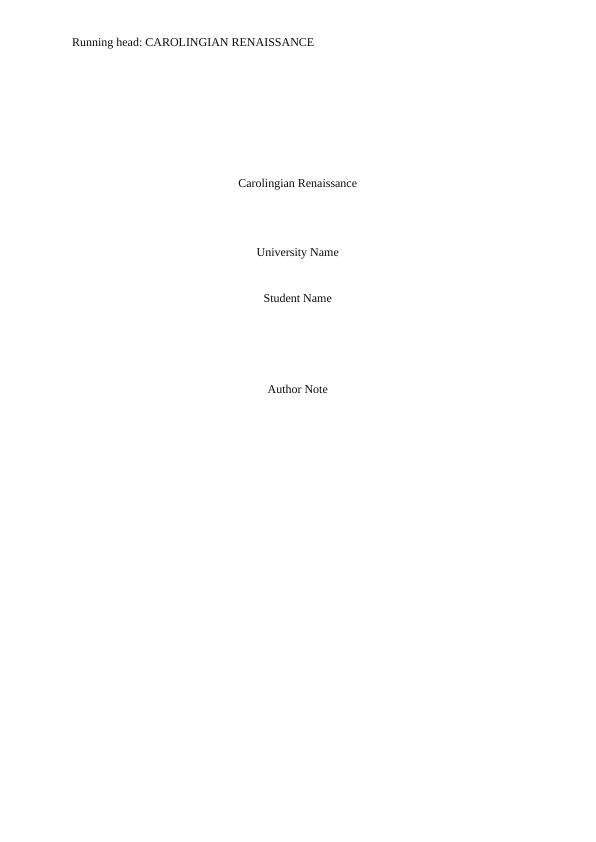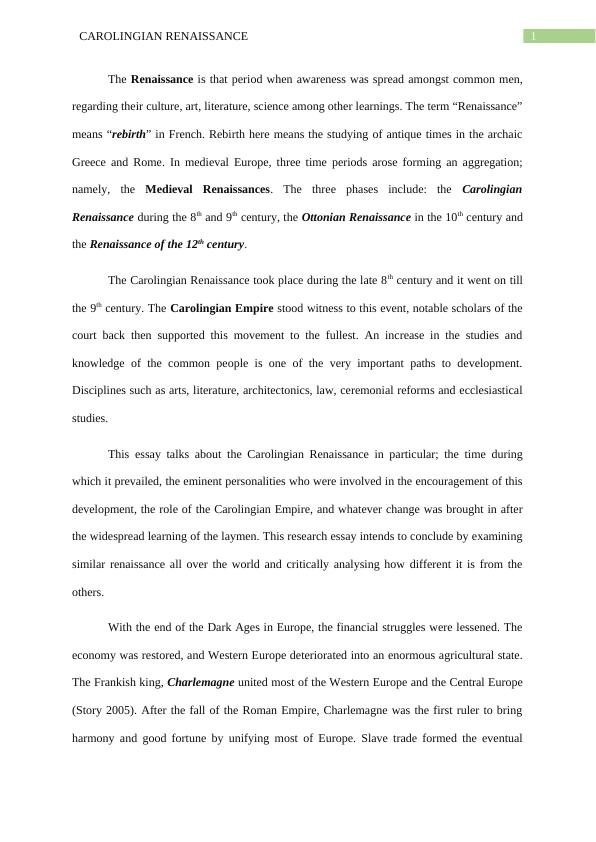Carolingian Renaissance: A Revival of Antique Principles in the Frankish Empire
Added on 2023-06-10
10 Pages3017 Words249 Views
Running head: CAROLINGIAN RENAISSANCE
Carolingian Renaissance
University Name
Student Name
Author Note
Carolingian Renaissance
University Name
Student Name
Author Note

1CAROLINGIAN RENAISSANCE
The Renaissance is that period when awareness was spread amongst common men,
regarding their culture, art, literature, science among other learnings. The term “Renaissance”
means “rebirth” in French. Rebirth here means the studying of antique times in the archaic
Greece and Rome. In medieval Europe, three time periods arose forming an aggregation;
namely, the Medieval Renaissances. The three phases include: the Carolingian
Renaissance during the 8th and 9th century, the Ottonian Renaissance in the 10th century and
the Renaissance of the 12th century.
The Carolingian Renaissance took place during the late 8th century and it went on till
the 9th century. The Carolingian Empire stood witness to this event, notable scholars of the
court back then supported this movement to the fullest. An increase in the studies and
knowledge of the common people is one of the very important paths to development.
Disciplines such as arts, literature, architectonics, law, ceremonial reforms and ecclesiastical
studies.
This essay talks about the Carolingian Renaissance in particular; the time during
which it prevailed, the eminent personalities who were involved in the encouragement of this
development, the role of the Carolingian Empire, and whatever change was brought in after
the widespread learning of the laymen. This research essay intends to conclude by examining
similar renaissance all over the world and critically analysing how different it is from the
others.
With the end of the Dark Ages in Europe, the financial struggles were lessened. The
economy was restored, and Western Europe deteriorated into an enormous agricultural state.
The Frankish king, Charlemagne united most of the Western Europe and the Central Europe
(Story 2005). After the fall of the Roman Empire, Charlemagne was the first ruler to bring
harmony and good fortune by unifying most of Europe. Slave trade formed the eventual
The Renaissance is that period when awareness was spread amongst common men,
regarding their culture, art, literature, science among other learnings. The term “Renaissance”
means “rebirth” in French. Rebirth here means the studying of antique times in the archaic
Greece and Rome. In medieval Europe, three time periods arose forming an aggregation;
namely, the Medieval Renaissances. The three phases include: the Carolingian
Renaissance during the 8th and 9th century, the Ottonian Renaissance in the 10th century and
the Renaissance of the 12th century.
The Carolingian Renaissance took place during the late 8th century and it went on till
the 9th century. The Carolingian Empire stood witness to this event, notable scholars of the
court back then supported this movement to the fullest. An increase in the studies and
knowledge of the common people is one of the very important paths to development.
Disciplines such as arts, literature, architectonics, law, ceremonial reforms and ecclesiastical
studies.
This essay talks about the Carolingian Renaissance in particular; the time during
which it prevailed, the eminent personalities who were involved in the encouragement of this
development, the role of the Carolingian Empire, and whatever change was brought in after
the widespread learning of the laymen. This research essay intends to conclude by examining
similar renaissance all over the world and critically analysing how different it is from the
others.
With the end of the Dark Ages in Europe, the financial struggles were lessened. The
economy was restored, and Western Europe deteriorated into an enormous agricultural state.
The Frankish king, Charlemagne united most of the Western Europe and the Central Europe
(Story 2005). After the fall of the Roman Empire, Charlemagne was the first ruler to bring
harmony and good fortune by unifying most of Europe. Slave trade formed the eventual

2CAROLINGIAN RENAISSANCE
reason of the sudden development of economy; where, the aristocratic Arabs caused a higher
demand for European serf after the rise of the Arab Empire (Beckwith 1993). Due to the
battles and invasions that were going on in Eastern Europe, a fixed supply of the enslaved
Slavs was sent to the Frankish and Italian traders who in turn sold them to the Spanish
Muslims and other parts of the Muslim world (Irwin 1986). The trade was so lucrative that it
almost instantly changed the European economies for the better. The market for Slavs
permitted the west to re-engage with the more sophisticated culture of East so that other
manufactories like that of textiles could grow.
In disparity with the overall deterioration of Western Europe from the 7th century, the
epoch of Charlemagne records a significant rejuvenation and critical juncture. Through his
use of accessible capitals such as the Church, Irish apostles, and manorial and primitive
institutions, his friendly association with the papacy, and his abundant administrative and
religious reforms, Charlemagne was able to stop the radical and traditional fragmentation of
the early Middle Ages and laid the groundwork for sturdy central government, north of the
Alps (Einhard 1960). Partly because of Charlemagne's activity, northern Europe arose in the
high and late Middle Ages as the overriding financial, dogmatic, and ethnic force in the West.
In the Carolingian era, the official court language used was Latin, so when Western
Europeans who had limited Latin vocabulary were the only ones serving as court transcribers,
it was of severe problem for the rulers. Another problem these rulers faced was when they
realized that not every district minister could read the Vulgate Bible (Metzger 1993). The
Sermo Vulgaris of the Latin dialect soon started to branch into different other local lingos, the
forerunner of the present day’s Romance languages (Bamman and Crane 2006). These
became equally incomprehensible and stopped intellectuals of a part of Europe from
communicating with people from other parts of the country.
reason of the sudden development of economy; where, the aristocratic Arabs caused a higher
demand for European serf after the rise of the Arab Empire (Beckwith 1993). Due to the
battles and invasions that were going on in Eastern Europe, a fixed supply of the enslaved
Slavs was sent to the Frankish and Italian traders who in turn sold them to the Spanish
Muslims and other parts of the Muslim world (Irwin 1986). The trade was so lucrative that it
almost instantly changed the European economies for the better. The market for Slavs
permitted the west to re-engage with the more sophisticated culture of East so that other
manufactories like that of textiles could grow.
In disparity with the overall deterioration of Western Europe from the 7th century, the
epoch of Charlemagne records a significant rejuvenation and critical juncture. Through his
use of accessible capitals such as the Church, Irish apostles, and manorial and primitive
institutions, his friendly association with the papacy, and his abundant administrative and
religious reforms, Charlemagne was able to stop the radical and traditional fragmentation of
the early Middle Ages and laid the groundwork for sturdy central government, north of the
Alps (Einhard 1960). Partly because of Charlemagne's activity, northern Europe arose in the
high and late Middle Ages as the overriding financial, dogmatic, and ethnic force in the West.
In the Carolingian era, the official court language used was Latin, so when Western
Europeans who had limited Latin vocabulary were the only ones serving as court transcribers,
it was of severe problem for the rulers. Another problem these rulers faced was when they
realized that not every district minister could read the Vulgate Bible (Metzger 1993). The
Sermo Vulgaris of the Latin dialect soon started to branch into different other local lingos, the
forerunner of the present day’s Romance languages (Bamman and Crane 2006). These
became equally incomprehensible and stopped intellectuals of a part of Europe from
communicating with people from other parts of the country.

End of preview
Want to access all the pages? Upload your documents or become a member.
Related Documents
Introduction to Modern Europelg...
|10
|2805
|31
How Renaissance and Reformation strengthened the statelg...
|12
|4115
|121
The European Renaissance Essaylg...
|5
|657
|933
The Origins, Success, and Failure of Arab Nationalism in the Interwar Periodlg...
|11
|2671
|333
Comparison of Byzantium, Islam and Western Civilization & Causes, Characteristics and Effects of Medieval Crusadeslg...
|7
|2128
|300
Age of Exploration and its Consequences PDFlg...
|5
|1147
|29
